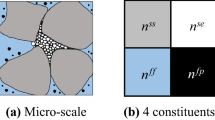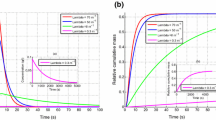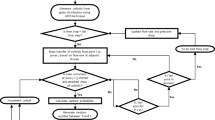Abstract
To construct the foundations, tunnels and underground structures in loose rocks, the soil has to be strengthened and protected from formation and flood waters. Liquid grout pumped into the loose soil under pressure, filters in the pores and strengthens the porous rock. A porous rock with a hardened hardener forms a new building material. The use of reinforcements with dissimilar particles makes it possible to obtain a variety of building materials with desired properties. The paper purpose is modeling of filtration of a bidisperse suspension or colloid in a porous media with linear filtration and concentration functions and a size-exclusion particle capture mechanism. The problem is solved numerically by the finite difference method. The retention profiles of large and small particles and the total retention are constructed for different times. The main result of the work is the uneven distribution of the sediment depending on the particle size. The profiles of large particles always decrease monotonically, the profiles of small particles decrease monotonically at a short time and monotonically increase at a long time. The profiles of the total retention retain or change their monotonicity depending on the parameters of the problem. At some time, a maximum point appears on the plots of non-monotonic profiles, moving from the entrance to the exit of the porous media with increasing time. The limit velocity of maximum points movement of non-monotonic profiles depends on the model coefficients. This makes it possible to describe the properties of materials obtained by filtration of bidisperse suspensions in a porous medium theoretically.
Access provided by Autonomous University of Puebla. Download conference paper PDF
Similar content being viewed by others
Keywords
- Deep bed filtration
- Suspension
- One-dimensional filtration problem
- Retention profile
- Large and small particles
1 Introduction
In order to construct tunnels and underground structures, it’s necessary to strengthen the loose rock and make a waterproof wall in the ground. Liquid grout pumped into the loose soil under pressure, filters in the pores, strengthens the porous rock and prevents the flow of formation water [1, 2].
When filtering suspensions and colloids in a porous media, some particles pass freely from entrance to exit, others stick in the pores and form sediment. With deep bed filtration, the deposit forms throughout the porous media, not just at the entrance. Particles are retained in the porous media either in the throats of narrow pores or in wide pores under the influence of electric, hydrodynamic, gravitational forces, diffusion into dead-end pores, etc. [3]. When filtering a 2-part suspension, the ыyвшьyтe is unevenly distributed. The aim of this work is to study the distribution of deposited particles on the framework of a porous media, depending on the type of particles.
To study the suspension filtration in a porous media, mathematical modeling methods are used [4, 5]. The classical model of deep bed filtration of a monodisperse suspension in a porous media with a size-exclusion particle capture mechanism includes the kinetic equation of sediment growth and the mass balance equation of suspended and retained solids [6]. For some one-dimensional models, exact analytical solutions are obtained, for a wide class of models it is possible to construct asymptotics [7,8,9]. We can use numerical methodsfor unknown analytical solutions [10, 11].
The most important characteristic of the filtration process is the retention profile—the dependence of retained particles concentration on the spatial coordinate at a fixed time. The profiles of a monodisperse suspension always decrease monotonically. If suspensions or colloids contain particles of different sizes, the profiles lose their monotony. In [12], the profiles of 2-particle colloids formed during filtration in a porous media were calculated. The profiles of large particles keep a monotonic decrease, while the profiles of small particles change monotonicity. The behavior of the total retention profile depends on the parameters of the problem.
The filtration problem of a 2-particle suspension is considered in the paper. The retention profiles of large and small particles and the total retention are plotted. The process of transition of the profiles of small particles and total retention from a monotonic decrease at a short time to a monotonic increase at a long time is investigated. At some time, a maximum point appears on the profiles, which moves from the entrance to the exit of the porous media. The velocity of maximum point movement and its asymptotics for a large time are calculated.
2 Mathematical Models
The mathematical model assumes that the filtration function is linear and blocking (Langmuir coefficient), and the suspended solids concentration is small. In this case, the concentration function is linear [13].
In the domain \(\Omega = \{ x \ge 0,\,t \ge 0\} ,\) consider the quasilinear hyperbolic system
for unknown concentrations of suspended \(c_{i}\) and retained \(s_{i}\) solids, where
and \(\lambda _{1} ,\,\,\,\lambda _{2} ,\,\,B_{1} ,\,\,B_{2} ,\,\,c_{1}^{0} ,\,\,\,c_{2}^{0}\) are positive values, \(c_{1}^{0} + c_{2}^{0} = 1\).
The uniqueness of the solution to system (1), (2) is ensured by the boundary and initial conditions
The suspended and retained solidsconcentration front \(t = x\) divides the domain Ω into two zones. In zone \(\Omega _{0} = \{ x \ge 0,\,\,0 < t < x\}\) there are no suspended and retained solids and there is zerosolution. In zone \(\Omega _{1} = \{ x \ge 0,\,\,t > x\}\) there are suspended and retained solids, in \(\Omega _{1}\) there is positivesolution. The conditions (4) and (5) are not compatible at the origin, the solution \(c_{i}\) is discontinuous at the front of concentration; in the Ω the solution \(s_{i}\) is continuous.
On the front of concentration \(t = x\) the solution \(s_{1} = 0,\,\,\,\,s_{2} = 0\). Substitute Eq. (2) into (1)
Solution of the Eqs. (6) with the conditions (4)
Formula (7) determine the solution on the concentration front from the side of zone \(\Omega _{1}\) (behind the front), ahead of the front the solution is zero.
Below we study the solution in zone \(\Omega _{1}\), where the solution to the problem is continuous and positive.
The exact solution for a monodisperse suspension was obtained in [14]. For a bidisperse suspension, the analytical solution in zone \(\Omega _{1}\) is unknown, the problem is calculated.
3 Numerical Calculation
The calculation of the problem was performed by the finite difference method according to an explicit difference scheme [15,16,17]. The grid steps in time and coordinate were chosen in accordance with the Courant convergence condition [18]. In Fig. 1 the profiles of total deposit (green line) and partial deposits of large (blue line) and small (red line) particles are presented at different times. The curves are obtained for parameters \(c_{1}^{0} = c_{2}^{0} = 0.5\), \(B_{1} = 0.125\), \(B_{2} = 0.025\), \(\lambda _{1} = 5\), \(\lambda _{2} = 25\).
According to Fig. 1 the profiles of large particles decrease monotonically at any fixed time. The retention profiles of small particles decrease monotonically at a short time and increase monotonically at a long time. The profiles of the total deposit retain a monotonic decrease or change the monotonicity depending on the problem parameters. The variationof the monotonicity of the profiles is associated with the appearance of a maximum point separating the monotonically increasing part of the plot from the monotonically decreasing one. With increasing time, the maximum point moves from the entrance to the exit of the porous media, gradually increasing the increasing part of the plot. The maximum point on the profile of the total retention lags behind the maximum point of the small particle retention.
The limit velocities of the profile maximum point are shown in Table 1. The velocities \(v_{2}\) of small particles retention profile and \(v_{0}\) of total retention profile are calculated as the slope of the asymptote at large times.
Table 1 shows that the limit maximum points velocities of small particles retention profile and total retention profile coincide. When changing any parameter, the velocity of maximum points changes disproportionately. With a proportional change of the coefficients \(\lambda _{1} ,\,\lambda _{2}\), the limit velocity does not change. Thus, the limit velocity of maximum points is a nonlinear function of its parameters, a uniform degree of zero in terms of parameters \(\lambda _{1} ,\,\lambda _{2}\).
In Fig. 2 the dependence on time of maximum points of the profiles is shown for parameter from Table 1 (Fig. 2a corresponds to the first line of the Table, Fig. 2b corresponds to the second line of the Table, etc.). Green line corresponds to the maximum points of total deposit profiles and red line corresponds to the maximum points of partial deposit of small particles.
Maximum points of the profiles for parameters \(\lambda _{1} ,\,\,\lambda _{2} ,\,\,B_{1} ,\,\,B_{1} ,\,\,c_{1}^{0} ,\,\,c_{2}^{0}\) given in Table 1
Figure 2 show that the plots of the maximum points have an asymptote. Consequently, the velocity of maximum points tends to a constant with an unlimited increase in time.
4 Discussion
In the paper a numerical solution is received for a one-dimensional filtration problem of a suspension with 2-size particles in a porous media. The retention profiles of large and small solids, as well as of total retention profile, were constructed.
The retention profiles of large particles decrease monotonically at any time. The retention profile of small particles is not monotonic. The total retention profile either always decreases monotonically or changes monotonicity depending on the parameters.
For a short time, all profiles decrease monotonically. With increasing time, a maximum point appears on the profiles, moving from the entrance to the exit of the porous media. The maximum point of total retention profile lags behind the maximum point of the profile of small particles. When the maximum point reaches the exit of the porous media, the profile becomes monotonically increasing.
With a long time, the limit velocities of the maximum points of the total and partial retention profiles coincide. The velocity depends nonlinearly on the coefficients of the problem and is homogeneous in parameters \(\lambda _{1} ,\,\lambda _{2}\).
5 Conclusions
The profiles of sediments—the distribution of trapped particles in a porous media depending on the distance to the entrance at a fixed time—have been investigated. It is shown that the monotonicity of the profiles depends on the given time and on the type of particles. The profiles of large particles always decrease monotonically, while the profiles of small particles decrease monotonically at a short time and increase monotonically at a long time.
Intermediate profiles of small particle and full sediment profiles have a maximum point that moves from entrance to exit with increasing time. For suspension with 2-size particles in a porous mediathe limit maximum points velocities of small particles retention profile and total retention profile coincide. The velocity of maximum points tends to a constant with an unlimited increase in time.
This work makes it possible to describe the properties of inhomogeneous materials obtained by filtration of bidisperse suspensions in a porous media theoretically. It is shown that the properties of materials depend on both the particle size of the suspension and the filtration time.
The study of retention profiles becomes more difficult if the filtration and concentration functions are non-linear [19]. Behavior of profiles of a polydisperse suspension containing particles of 3 or more different sizes is also of interest. Separate studies will be devoted to these problems.
Calculation of retention profiles allows fine tuning of experiments and decrease the cost and amount of laboratory experiments [20, 21].
References
Bedrikovetsky P (2013) Mathematical theory of oil and gas recovery: with applications to ex-USSR oil and gas fields. Springer Science and Business Media
Civan F (2014) Reservoir formation damage. Gulf Professional Publishing, Burlington, MA, USA
Tsuji M, Kobayashi S, Mikake S, Sato T, Matsui H (2017) Post-grouting experiences for reducing groundwater inflow at 500 m depth of the mizunami underground research laboratory. Procedia Eng 191:543–550
Tien C (2012) Principles of filtration. Elsevier, Oxford
Herzig JP, Leclerc DM, Legoff P (1970) Flow of suspensions through porous media—application to deep filtration. Ind Eng Chem 62(5):8–35
Vyazmina EA, Bedrikovetskii PG, Polyanin AD (2007) New classes of exact solutions to nonlinear sets of equations in the theory of filtration and convective mass transfer. Theor Found Chem Eng 41(5):556–564
Kuzmina LI, Osipov YV, Zheglova YG (2018) Analytical model for deep bed filtration with multiple mechanisms of particle capture. Int J Non-Linear Mech 105:242–248
Zhang H, Malgaresi GV, Bedrikovetsky P (2018) Exact solutions for suspension-colloidal transport with multiple capture mechanisms. Int J Non-Linear Mech 105:27–42
Fogler HS (2006) Elements of chemical reaction engineering. Prentice Hall, Upper Saddle River, NJ
Kuzmina L, Osipov Y (2018) Deep bed filtration with multiple pore-blocking mechanisms. MATEC Web Conf 196:04003
Wang S (2018) An improved high order finite difference method for non-conforming grid interfaces for the wave equation. J Sci Comput 77:775–792
Osipov Y, Safina G, Galaguz Y (2018) Calculation of the filtration problem by finite differences methods. MATEC Web Conf 251:04021
Galaguz YuP, Safina GL (2016) Modeling of particle filtration in a porous media with changing flow direction. Procedia Eng 153:157–161
Safina GL (2019) Numerical solution of filtration in porous rock. E3S Web Conf 97, 05016
Crist JT, Zevi Y, McCarthy JF, Throop JA, Steenhuis TS (2005) Transport and retention mechanisms of colloids in partially saturated porous media. Vadose Zone J 4(1):184–195
Riisgard HU, Larsen P (2010) Particle-capture mechanisms in suspension-feeding invertebrates. Mar Ecol Prog Ser 418:255–293
You Z, Bedrikovetsky P, Badalyan A, Hand M (2015) Particle mobilization in porous media: temperature effects on competing electrostatic and drag forces.Geophy Res Lett 42(8), 2852–2860
Borazjani S, Bedrikovetsky P (2017) Exact solutions for two-phase colloidal-suspension transport in porous media. Appl Math Model 44:296–320
Kuzmina LI, Nazaikinskii VE, Osipov YuV (2019) On a deep bed filtration problem with finite blocking timerussian. J Math Phys 26(1):130–134
Yang S, Russell T, Badalyan A, Schacht U, Woolley M, Bedrikovetsky P (2019) Characterisation of fines migration system using laboratory pressure measurements. J Nat Gas Sci Eng 65, 108–124
Vaz A, Maffra D, Carageorgos T, Bedrikovetsky P (2016) Characterisation of formation damage during reactive flows in porous media. J Nat Gas Sci Eng 34:1422–1433
Author information
Authors and Affiliations
Editor information
Editors and Affiliations
Rights and permissions
Copyright information
© 2022 The Author(s), under exclusive license to Springer Nature Switzerland AG
About this paper
Cite this paper
Safina, G. (2022). Calculation of Retention Profiles in Porous Medium. In: Akimov, P., Vatin, N. (eds) Proceedings of FORM 2021. Lecture Notes in Civil Engineering, vol 170. Springer, Cham. https://doi.org/10.1007/978-3-030-79983-0_3
Download citation
DOI: https://doi.org/10.1007/978-3-030-79983-0_3
Published:
Publisher Name: Springer, Cham
Print ISBN: 978-3-030-79982-3
Online ISBN: 978-3-030-79983-0
eBook Packages: EngineeringEngineering (R0)






